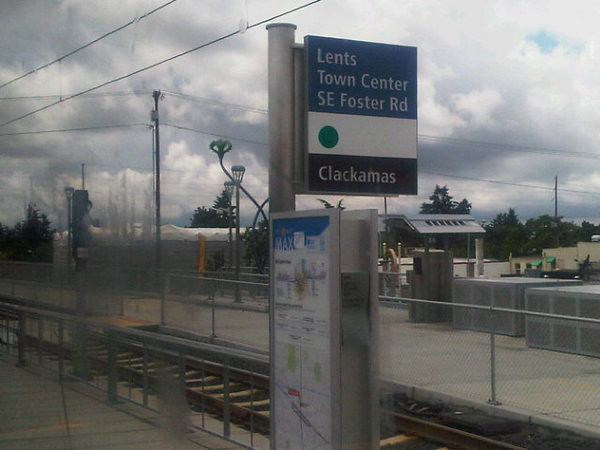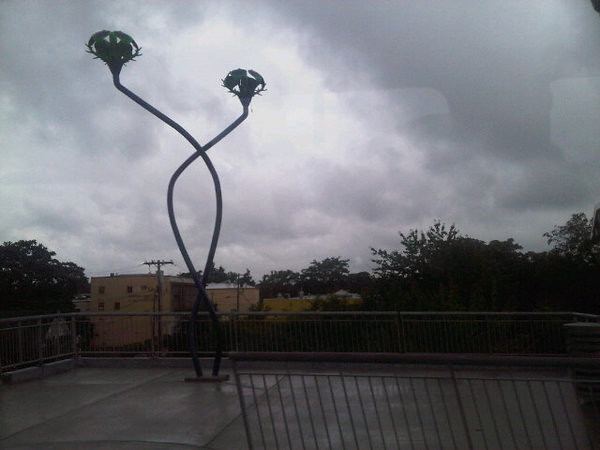Here are a few photos of Fountain for a Rose, the fountain in downtown Portland's O'Bryant Square. I don't have any photos of it running, unfortunately. Apparently the water bureau more or less abandoned it a few years ago, and the city's web page about municipal fountains doesn't bother mentioning it anymore It's a shame because it's quite attractive when it's running (its page at PortlandWaterFountains.com includes a photo). The city's page about the park as a whole still has a blurb about the fountain:
O'Bryant Square's dominant feature is a bronze fountain in the shape of a rose, fittingly titled Fountain to a Rose. It was made possible through a $28,000 bequest from Donald Card Sloan, who was a prime minister of the Royal Rosarians in 1953. Its inscription reads "May you find peace in this garden." The fountain is surrounded by 250 rose bushes and other plants. Beneath the fountain's jets an underground parking garage accommodates 90 cars, making it the first park with parking in the city. In 1976, O'Bryant Square received a national design award from the U.S. Department of Housing and Urban Development.
There seems to be some disagreement about whether the fountain is 'to' or 'for' a rose. The plaque on it says 'for', so that's what I went with, but the city's website says 'to', and 'to' is the name the Oregonian reported when the park & fountain were dedicated, on December 6th 1973. Incidentally, the date indicates the park celebrated its 40th birthday a week ago. No festivities were held as far as I know. I'm not sure the city even realized there was an anniversary to commemorate.
Back during the real estate bubble, O'Bryant Square was included in the Portland Development Commission's Three Downtown Parks master plan. The plan envisioned a new park at South Park Block 5 (which became today's Director Park), vaguely defined & unfunded renovations at Ankeny Park, and what sounds like a complete nuke-and-pave here. Various plans were offered, but they all seemed to involve tearing out the current park, removing the underground parking structure, and replacing it with something that hit all the buzzwords of contemporary architecture. Festival streets, LEED ultra-platinum sustain-o-licious green design, that sort of thing. This was supposed to happen at the same time Director Park was being built, circa 2007-08, but it's 2013 and nothing's happened yet.
A cynic might wonder if the master plan was only meant as a response to the "Let's tear down a bunch of buildings and connect all the Park Blocks" crowd, and they never really intended to build anything beyond Director Park. I'd actually be ok with that. Connecting the North & South Park Blocks is kind of dumb idea, and would involve tearing out a lot of old historic buildings. And I also don't think O'Bryant Square needs the proposed nuke-and-pave.
Over the past four decades, the park's acquired a bad reputation as a no-go zone full of hobos and junkies. I think this is outdated now; you may see a few teen skateboarders now and then, but they're harmless and they'll probably get bored and leave soon. But there may have been a kernel of truth to the stereotype twenty-some years ago. I was walking past the park one time, probably around 1990 or so, and a car drove past me slowly and somebody asked if I wanted to buy a (presumably stolen) car stereo. I was in college then and (in retrospect) may have looked like a potential customer for a stolen car stereo. But I also didn't own a car at the time. I explained this and got a "Dude, c'mon, twenty bucks." I also didn't have twenty bucks to spare, but I just explained I really genuinely did not own a car and therefore wasn't in the market for a stereo, no matter how awesome of a deal it was, and how cool and generous they were for offering it to me. So they drove off, dejected. The End. Ok, so this wasn't actually a scary story, but it's all I've got. If you have a better scary O'Bryant Square story, feel free to leave a comment below.
Anyway, the point of all of this is that I think they figured the whole park would be torn out soon, so there was no point in spending the money to keep the fountain running. The master plan has been neither implemented nor officially abandoned, so the fountain seems to be in a state of limbo these days. It probably doesn't help that the city's fountains were handed over from the Water Bureau to the Parks & Recreation Bureau recently, so Fountain for a Rose may not even be on the parks bureau's radar.
This is kind of sad because the park's taken on a new role in recent years, as a seating area for the popular food cart pod just across Washington Street. If the city's really so concerned about the park looking "blighted", you'd think leaving its fountain dry and apparently broken for years on end, in a spot where it will increasingly be seen by tourists, is not something they'd want to be doing.


